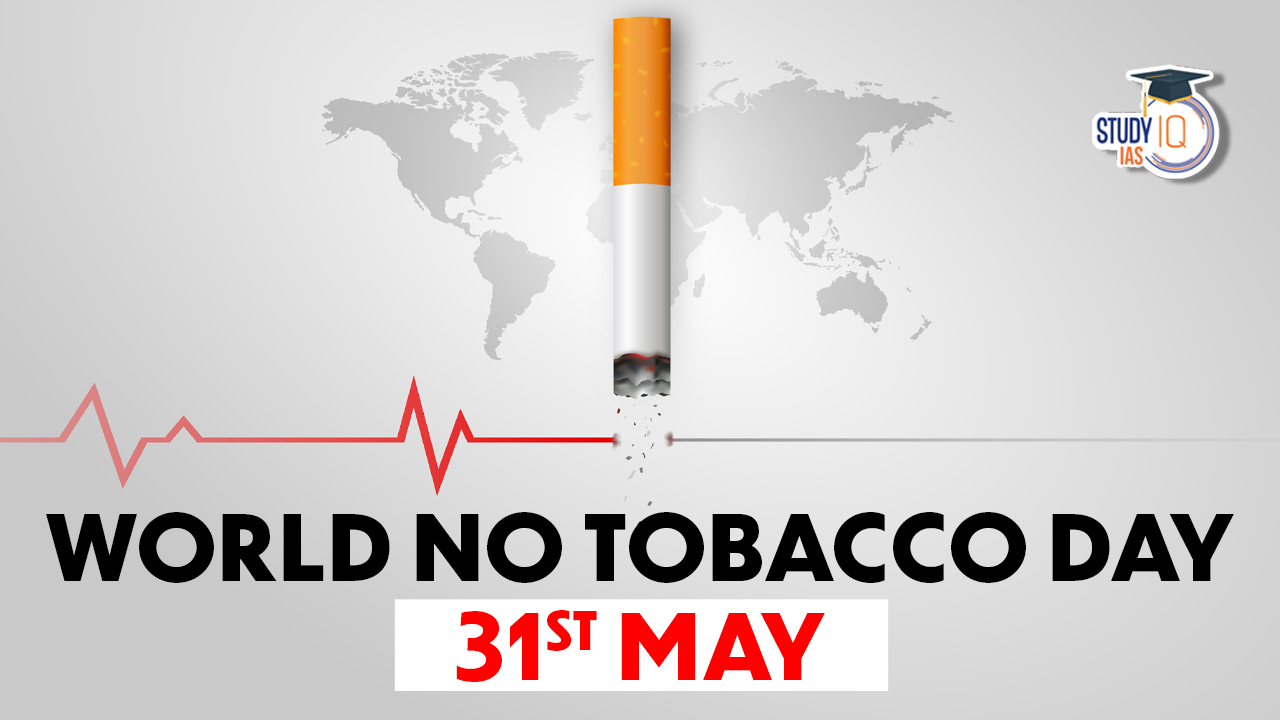Table of Contents
World No Tobacco Day 2025 takes place on May 31, marking the international initiative by the World Health Organisation (WHO) to raise awareness about the devastating impact of tobacco consumption and promote effective policies to curb tobacco use. Check out details on World No Tobacco Day 2025, History, Theme and Significance in this article.
World No Tobacco Day 2025
World No Tobacco Day 2025 is a call to action for individuals, communities, and governments to take decisive steps towards a tobacco-free world, using the hashtag #TobaccoExposed. This involves policy measures to curb tobacco advertisement, particularly among youth, and tobacco cessation programs to assist people in quitting tobacco use.
World No Tobacco Day 2025 Theme
The theme for World No Tobacco Day 2025 is “Unmasking the Appeal: Exposing Industry Tactics on Tobacco and Nicotine Products.
This theme uniquely addresses exposing and countering the sinister tactics of the tobacco and nicotine industries to make their dangerous products appealing, particularly among youth. It attempts to uncover how these industries utilise appealing tastes, modern product designs, and misleading advertising (including social media) to hook new users and keep existing ones hooked.
World No Tobacco Day 2025: Events
Global Initiatives
- WHO Online Event: The World Health Organisation conducted a virtual session on May 13, “Exposing Lies, Protecting Lives”, the methods employed by the tobacco industry to engage young consumers with flavoured products and attractive designs.
- IARC Campaign: The International Agency for Research on Cancer carried forward its #TobaccoExposed campaign, emphasising the strategies of the industry to lure youth into nicotine dependence.
National Events in India
- Project UMEED: AIIMS Gorakhpur, in partnership with ECHO India, initiated Project UMEED—a peer-based initiative to prevent drug abuse among teenagers. The initiative is being rolled out in six major medical institutions and 108 schools all over the country, to develop resilience and knowledge about the risks of tobacco, alcohol, and drugs.
- OraLife Initiative: Apollo Cancer Centres launched the OraLife initiative to deal with the growing oral cancer epidemic in India. The program focuses on early detection through oral cancer screening and involves collaborations with bodies such as the Isha Foundation to facilitate people in overcoming tobacco dependence.
- MyGov Awareness Quiz: The Ministry of Education, along with MyGov, created an online Tobacco Awareness Quiz that informs students about the ill effects of tobacco and tobacco industry marketing strategies. The quiz has various languages and is accessible to every Indian citizen.
Top 10 Largest Tobacco Producing Countries
Here are the Top 10 Largest Tobacco-Producing Countries in the world based on the most recent global agricultural data:
| Rank | Country | Estimated Annual Production (in metric tons) |
|---|---|---|
| 1 | China | ~2.6 million |
| 2 | India | ~800,000 |
| 3 | Brazil | ~675,000 |
| 4 | Indonesia | ~260,000 |
| 5 | Zimbabwe | ~200,000 |
| 6 | United States | ~180,000 |
| 7 | Pakistan | ~135,000 |
| 8 | Bangladesh | ~120,000 |
| 9 | Turkey | ~110,000 |
| 10 | Philippines | ~100,000 |
- China dominates by far and is responsible for more than 40% of the world’s tobacco output.
- India is the second-largest producer and one of the biggest exporters, especially of flue-cured Virginia.
- Tobacco is a major cash crop in Brazil, Zimbabwe, and Indonesia.
- Rankings will differ somewhat between years and sources (FAO, USDA, etc.).
World No Tobacco Day (WNTD): Historical Background
- Initiated by the World Health Organisation (WHO): The concept of World No Tobacco Day was adopted by the World Health Assembly in 1987.
- First Observance: The first WNTD was observed on April 7, 1988, as the 40th anniversary of the WHO. Subsequently, the date was shifted to May 31 from 1989.
- The motive was to promote 24 hours of not consuming tobacco in any form in the world.
Objectives
- Raise public awareness of the health harms caused by tobacco
- Reduce the incidence of smoking and use of smokeless tobacco
- Encourage governments to enact effective tobacco control legislation
- Promote cessation efforts to help individuals quit tobacco
- Safeguard future generations against the strategies of the tobacco industry
Major Milestones in Tobacco Control
- 2003: WHO adopted the Framework Convention on Tobacco Control (FCTC)—the world‘s first public health treaty.
- Annual Themes: WNTD highlights a special theme every year, like tobacco and lung health, protection of youth, or the environment.
Significance of World No Tobacco Day
- Creating Awareness: It acts as an important platform to inform the public, policymakers, and communities about the harmful health, social, environmental, and economic impacts of tobacco consumption.
- Avoidable Deaths: Use of tobacco is among the most avoidable causes of death in the world, accounting for more than 8 million deaths annually, including secondhand smoke.
- Advocacy for Policy Change: The day calls upon governments to adopt more stringent tobacco control policies, including prohibition of flavors, plain packaging, tax rises, advertising prohibition, and smoke-free public areas.
- Youth Protection: One of the main focuses is to protect children and youth from tobacco companies‘ aggressive marketing practices.
Quitting Support: It also encourages and supports quitting attempts, pointing out resources and means.


 List of Awards and Honours Received by N...
List of Awards and Honours Received by N...
 List of GI Tag Products in India 2025, S...
List of GI Tag Products in India 2025, S...
 Hurun Global Unicorn Index 2025: Key Hig...
Hurun Global Unicorn Index 2025: Key Hig...





















